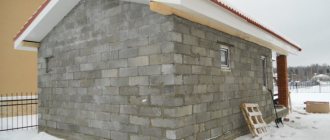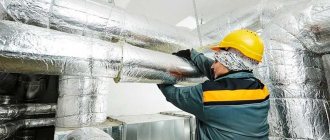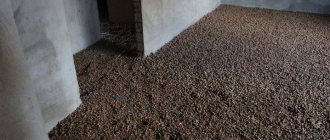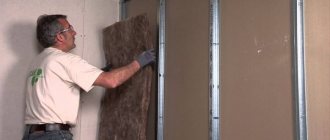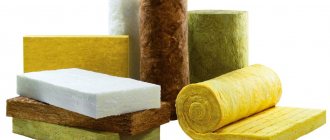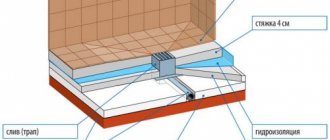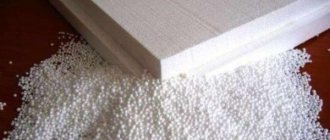Many owners of country plots dream of having their own bathhouse. But putting up a log house is quite expensive. The solution to this issue is to build bathhouse walls from cinder blocks - this is much cheaper and faster in terms of construction time.
In order for such a bathhouse to keep warm for a long time, it must be insulated with modern materials. Moreover, such work must be carried out not only from the outside, but also from the inside. We will focus on insulating a cinder block bathhouse in this article.
What you need to know
You can’t do without additional knowledge: when carrying out work, you should take into account not only structural features, but also the impact of the environment. The insulation of a cinder block bathhouse from the outside is strikingly different from the internal insulation. The preservation of heat also depends on the correct choice of high-quality insulation materials.
The insulation process should begin at the most important stage of construction, which is the thermal insulation of the floor. To do this, it is worth pouring a layer of slag or expanded clay onto the base soil. The height of the poured layer should be twice as thick as the wall.
Scheme of floor insulation in a bathhouse
A reinforced expanded clay concrete screed is laid on the insulating layer, on which ceramic tiles are subsequently laid. In addition to expanded clay and slag, it is possible to use polymer materials as floor insulation, among which glass wool is effective and popular.
Interior finishing: final work
Preference has always been on the side of wood. It is convenient, hygienic, and easy to replace if necessary. Not to mention that different types of wood have different healing effects on the human body, and their very atmosphere is an integral part of traditional bath culture.
The tree must be one that is not capable of overheating and causing a burn to a person. For the interior decoration of the steam room, initially only deciduous varieties were used: ash, alder, birch, poplar, larch, aspen, linden. Resinous types of trees and any conifers are unsuitable for interior finishing. And the choice in the design of a washing room is practically unlimited: ceramic tiles, plasterboard, and any moisture-resistant decorative materials are appropriate here.
Internal insulation
The structure of cinder blocks is porous, which allows for excellent heat retention, but the same porous surface absorbs moisture. Therefore, maximum protection of the walls eliminates the accumulation of moisture inside the blocks.
Before insulation, the internal walls of the bathhouse are lathed with wooden slats at least 50 mm thick, on which a layer of mineral wool, basalt insulation, polystyrene foam or any other material is laid. The thermal insulation layer is covered with foil film or aluminum foil, which performs the function of waterproofing. Particular attention should be paid to the tightness of the joints of all layers.
As the most effective way to insulate a bath, experts recommend vapor barrier with polypropylene foam, which is covered with aluminum foil. The ability of this material to withstand heat up to 150°
Aluminum foil is used as a material for insulating seams. If such insulation is insufficient, it is possible to lay one layer of non-combustible mineral wool between the wall and the vapor barrier layer.
Building a bathhouse with your own hands
Experts conditionally divide the construction of a bathhouse into several stages: construction of the foundation, walls, roof and floor, insulation, interior and exterior decoration.
First of all, we prepare the area
We clear it of debris, remove the top layer of soil, it is important to remove turf and various vegetation
We make markings, drive pegs into the corners of the future building and stretch a rope between them. As you work, measure the corners of the future building; they should be 90 degrees.
If you have a columnar foundation, mark the placement of the pillars; if you have a strip foundation, mark the width of the foundation.
The foundation is the basis of any building, so pouring the foundation is very important. To make a foundation, you need to dig a pit, compact and level the soil and fill it with concrete.
Cinder block is a fairly lightweight material, so the foundation for such a building can be strip or columnar.
The foundation must rise above the ground by at least half a meter so that the cinder block does not collapse, absorbing moisture.
When the foundation is dry, it must be covered with a waterproofing material - bitumen or roofing felt.
The next stage of work is the construction of walls. The laying of cinder block walls is approximately the same as that of brick.
Reinforcement must be laid every three rows of masonry to make the structure more durable. It is best to use metal mesh as reinforcement.
The last row of cinder blocks will end with bars, which will serve as the basis for the future roof.
It is also better to immediately lay window and door openings with wooden blocks.
You should also leave holes for ventilation and wiring of communications into the bathhouse.
Cinder block masonry technology on video.
Video:
The last stage of construction with your own hands will be the construction of the rafter system and roof.
For a bathhouse, a single-pitch or gable roof structure is usually used.
A pitched roof is the simplest option, which will cost very little and take minimal time to construct.
In the second case, the design will be a little more expensive and the work will take longer, but you will get additional storage space.
For a gable roof, you need to make a rafter system from beams and boards, which is covered with roofing material.
The roofing material for a bathhouse is usually slate, corrugated sheeting, ondulin or roofing felt, depending on your capabilities and desires.
Special attention should be paid to hydro- and vapor barrier of the bathhouse roof; it is also necessary to insulate the roof to retain heat in the steam room. Video:
Video:
External insulation
Cinder blocks with a porous structure quickly lose their properties without proper cladding, so you should not skimp on insulation. For external insulation, lining, siding or block house are often used, which are attached to wooden blocks fixed directly to the walls of the bathhouse.
In any case, special attention should be paid to creating an air gap. In this case, the layer of air between the materials will serve as a heat insulator. Some experts recommend insulating a bathhouse using plaster, but this method is labor-intensive and less effective.
Insulating a bathhouse from the inside: photos, diagrams and videos
So, how to insulate a bathhouse from the inside, depending on what material it was built from.
Features of log house thermal insulation
For a long time, no one has ever insulated a log bathhouse - not even the floors. The logs were simply changed from time to time and the lower crowns were repaired. But today, when a good log house and a real Russian steam room are almost a rarity, the question of high-quality insulation is far from the last. After all, its longevity depends on how protected the bathhouse is from moisture and cold.
In general, insulation in a wooden bath is necessary only when the dimensions of the timber are small; in all other cases, caulking and good waterproofing are sufficient. For the internal insulation of a steam room made of timber, a traditional “pie” with mineral wool is used - except that the thickness of the working layer itself can be 2 times less than for a steam room made of brick.
How to insulate a bathhouse made of foam, cinder blocks and concrete
Cinder blocks and foam blocks themselves have quite good thermal insulation materials due to their porous structure. But they can still freeze in the winter, and therefore it is necessary to additionally insulate the block bathhouse. Otherwise, all its walls will be pleased with unaesthetic dark damp spots in frosty weather.
Mineral wool and fiberglass are most suitable for such a bath. But in general, the whole pie must be provided with a reliable vapor barrier - any blocks really do not like high humidity in the air, and they absorb water like sponges. In general, it can be used as insulation and foam.
The first task when insulating the aerated concrete walls of a bathhouse is to remove the ice mass of concrete from the heating circuit. Why should the frame inside the entire structure be made indented from the walls? Moreover, the resulting space must be well ventilated - for this, special vent windows must be made on the outside at the top of the bathhouse and at the bottom. During bath procedures, they need to be closed, and while drying the bath, they need to be opened. And then the usual “pie” of insulation in the steam room and washing room is made. The most standard one looks like this: an aerated concrete or block wall - a frame for insulation with an indentation from the wall - insulation - board - vapor barrier where the steam room is - finishing with aspen or cedar boards. Thus, the ice walls do not have to be heated - that’s all the tricks.
Rules for insulating a frame bath
Option two: the insulation of a frame bath occurs according to this scheme. A vapor barrier made of parchment (or roofing felt, or roofing felt) is laid directly on the frame, which is secured by wood sheathing. Between the resulting internal and external walls you need to put foam plastic, fiberboard slabs or heat-insulating reed slabs. All this is covered on all sides with layers of asbestos cement, which makes the frame bath both stronger and warmer.
You can also insulate a frame bath using sawdust, gypsum and wood chips. All this is mixed with lime in a ratio of ten to one and laid in a thick layer between the outer and inner cladding. The main thing is that the sawdust is well dried and the layers are treated with iron sulfate.
Ventilated facade
The most reliable way to insulate a bathhouse is the ventilated facade method. Before starting work, brackets in the form of corners should be secured to the walls, and the space between the brackets should be narrower than the width of the seal.
Ventilated facade of a bathhouse using aerated concrete as an example. In a cinder block bathhouse, installation is carried out in the same way.
Between the metal corners we reinforce mineral wool mats. We seal the connecting joints with special tape. A waterproofing layer fixed to mineral wool mats will protect the insulation from moisture. After this, you can install additional fasteners for the final cladding of the facade. Glass wool or polystyrene foam can be used as insulation materials for exterior work.
Thermal insulation with expanded clay for wooden floors
Despite the fact that recently durable concrete floors are increasingly being installed, wooden floors remain relevant in bathhouses. They have a number of positive qualities:
- high level of environmental friendliness;
- good thermal insulation effect;
- When using the necessary protective equipment, their service life is quite long.
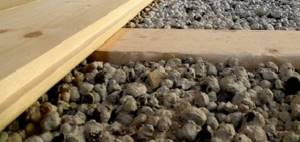
Before starting the process of insulating wooden floors in a bathhouse building, you will need to disassemble the flooring from the boards and thoroughly dry them naturally. The duration of their further operation will largely depend on the quality of drying. The insulation technology will look like this:
- removal of wooden flooring;
- laying skull beams;
- installation of vapor barrier material;
- securing rough boards;
- filling between the beams with an expanded clay layer;
- laying a layer to insulate from moisture;
- installation of floorboards.
Technology for performing insulation work
For high-quality and reliable thermal insulation, a whole range of insulation measures is required. That is, insulating the walls alone will not bring a tangible result - all surfaces must be sheathed from the inside with heat-insulating material. Let's take a closer look at the entire technology of insulating a bathhouse from the inside.
Floor insulation
The process of floor insulation begins almost immediately after the completion of the construction of walls and installation of the roof. You can save a lot on floor insulation if all the construction waste remaining after masonry is poured into the foundation pit and compacted thoroughly. Here it is important not to overdo it and leave about 50 cm for insulation.

In order to efficiently and reliably insulate the floor, you need to adhere to the following sequence of work:
- It is necessary to level the subfloor a little (with small construction waste, sand or earth) so that the insulation layer is uniform.
- Then expanded clay is poured into the space under the foundation. It is recommended to use it because it has high thermal insulation properties and excellent strength. The minimum layer should be 20–25 cm, more is possible.
- Expanded clay must be compacted thoroughly. You can spill it with water and let it sit for a few days to dry.
- Then a reinforcing mesh is laid on top of the expanded clay.
- The next step is pouring the cement mortar. Its thickness should be at least 10–15 cm.
- In the process of pouring the mortar, you need to follow the technology of a conventional screed: carefully level and smooth the surface, since this will be a subfloor.
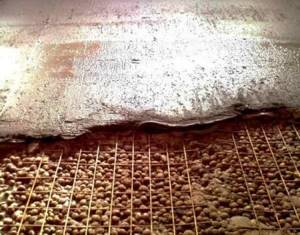
After the screed has completely hardened (about 10–14 days), you can begin arranging the finished floor, which can be done in several ways:
- One way is to lay ceramic tiles on a cement screed using an adhesive mixture.
- Another method is to lay wooden joists and lay a plank covering over them. The advantage of this method is the ability to additionally insulate the floor of the bathhouse by laying sheets of polystyrene foam or polyurethane foam between the joists.
Advice! Particular attention should be paid to the space near the foundation. Near it, the thickness of the expanded clay layer can be increased by 10 cm, which will make it possible to more reliably insulate the external walls and prevent freezing of the foundation.
Wall insulation
The next technological point is the insulation of the walls of the bathhouse. The work algorithm is as follows:
- First of all, in order to insulate the walls of the bathhouse from the inside, it is necessary to mount the frame. The sheathing can be made from wooden blocks treated with water-repellent impregnations or from galvanized profiles.
- Next, a layer of waterproofing is attached to the walls; ordinary dense polyethylene will do.
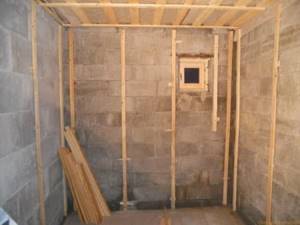
- After this, sheets of insulation, for example, basalt wool, are installed between the frame. The heat insulator can be further strengthened using plastic dowels with large caps.
- The third layer should be a foil material, for example penofol. In this case, the foil should be directed into the bathhouse to reflect heat flows.
- The final stage of insulating the walls of the bathhouse is the installation of the inner lining on the frame. Most often, wooden lining or tongue and groove boards are used for these purposes.
Features of using expanded clay when insulating the ceiling of a bath room
When insulating the ceiling of a bathhouse using expanded clay, the characteristics of the building material should be taken into account. It is not recommended to insulate with expanded clay if there is no attic space above the ceiling, since this material is capable of absorbing moisture. In the absence of an attic space, this may negatively affect the thermal insulation properties of the material. In addition, the moisture absorbed by the material contributes to the weighting of the material, which increases the load exerted by the insulation on the floors of the premises of the bathhouse complex.
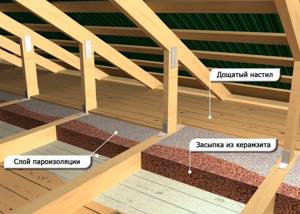
In order to avoid such a situation when installing an expanded clay insulation layer, additional waterproofing should be laid, which will prevent moisture from penetrating from the air to the insulation layer. A layer of insulation should be placed on top of a layer of expanded clay.
Making a layer of insulation using expanded clay is quite simple, since during the installation process it is not necessary to adjust the elements and carry out fastening work. During the work, it should be remembered that expanded clay, like any other bulk material, is capable of generating a large amount of dust when working with it. For this reason, it is recommended not to pour this building material onto bare boardwalks. To prevent dusting, it is recommended to lay expanded clay on a prepared substrate.
Before using expanded clay as the main insulating building material for the ceiling, the feasibility and effectiveness of using expanded clay should be analyzed. This is required due to the fact that the effectiveness of the material appears only with a layer thickness of over 100 mm.
To ensure high-quality thermal insulation, in some cases it may be necessary to form an insulating layer from 200 to 400 mm. Before forming a layer of insulation in the thickness of the floor, you will need to lay a layer of hydro- and vapor barrier between the floor boards and the layer of heat-insulating material.
We are building a bathhouse
We proceed directly to arranging a cinder block bathhouse.
There are simple instructions for this:
- Preparing for work. First of all, you need to determine the quality of the soil in the area where the building will be located.
Advice! The most acceptable option for construction is considered to be a rocky-sandy foundation. A foundation built on such soil will not need additional strengthening. If there is peat, fine sand or clay soil on the site, then you will have to additionally strengthen the foundation, since such a foundation can sooner or later cause subsidence of the structure, bringing it to an emergency condition.
- Since the building is relatively light in weight, both strip and column foundations are suitable for it.
- Cinder block bathhouse projects that provide a columnar base use concrete or brick pillars as supports, the dimensions of which are 0.5 by 0.5 meters. They must be installed in every corner, as well as in every node of the future building. The distance between such pillars should not exceed one and a half meters. If it is larger, the design will be unreliable.
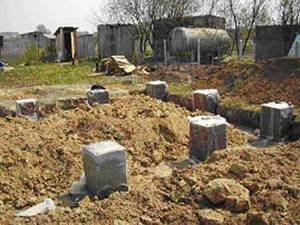
A grillage is mounted on top of the installed pillars - reinforced concrete crossbars that connect the supports into a single structure, after which the foundation is waterproofed.
Advice! If you use iron piles as supports, it is advisable to treat them with bitumen mastic in order to protect them from corrosion.
- Bathhouse designs made from cinder blocks on a strip foundation are very common. Such a base is a concrete strip laid under the load-bearing elements of the structure. Sometimes brick or stone is also used to construct such foundations, but concrete is more preferable.
- Roof. Here you have two options:
- If you do not plan to use the attic space, the roof must be made pitched.
- If you want to arrange an attic or attic above the living space, make a gable roof.
- Floor . The best option for a bathhouse is concrete floors. To drain water, the base is poured at a slight angle.
- Insulation . Cinder block bathhouse designs involve the use of various thermal insulation materials. Foam glass is an excellent insulation material for floor coverings, since this material is not at all afraid of water.
Advice! In this case, polystyrene foam should not be used as insulation, since this material is flammable and releases harmful substances into the atmosphere when heated.
Setting up a strip base

Before building a cinder block bathhouse, it is necessary to lay a reliable foundation for this building.
The work is carried out in several stages:
- Surface marking. Using pegs and fishing line, it is necessary to establish the boundaries of the foundation along which the trenches will be dug.
- Regarding the marking of the trench by the swarm, about 60 cm deep.
- We pour sand into the trench in a layer of 10 cm, which should be compacted well.
- We install the formwork. To do this, we drive pegs around the perimeter of the trench. We lean the formwork boards on them.
- We insert the reinforcement cage into the formwork. It is knitted from reinforcing rods, which are fastened together with wire.
- We fill the formwork with concrete. The solution gains strength within a month. After this time, the formwork can be removed and you can proceed directly to the construction of the walls.
Technology of building a house from expanded clay concrete
If you are building an expanded clay concrete house, follow the recommended technology and you will succeed.
Foundation
Professionals say that a strip foundation is most suitable for building a house made of expanded clay concrete blocks (by the way, just like a monolithic house). The technology for its arrangement is simple, so you can easily make the foundation needed for your house from expanded clay concrete blocks yourself. We carry out the following work:
- we dig a trench under the foundation (the width exceeds the width of the wall by 10-15 cm, and the depth is 50 cm);
- Place a sand cushion on the bottom (height – 15 cm);
- moisten the sand generously with water and tamp;
- pour a layer of crushed stone (15 cm high);
- compact the crushed stone;
- we arrange a waterproofing layer (for example, roofing felt);
- we install the formwork, which must be waterproofed;
- We make a reinforcing frame inside the formwork;
- pour concrete;
- after 5 days we remove the formwork, waterproof the upper and side surfaces of the foundation with mastic and roofing felt;
- fill the cavities between the foundation and the trench with sand;
- we take a break for 1-3 months so that the foundation settles;
- We are starting to lay the walls.
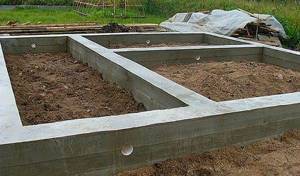
We lay expanded clay concrete wall blocks
The masonry algorithm looks like this:
- We lay roofing material on the foundation in 2-3 layers (coat each layer with mastic);
- place 2 blocks on the solution from each corner;
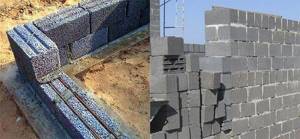
- along the entire perimeter we stretch a cord between the corner blocks, along which we align the laying of expanded clay concrete products of the first row;
- we check the masonry with a level, adjust the position of each block using a rubber mallet;
- we take a break for 1 day so that the row of masonry settles;
- We build subsequent rows in a checkerboard pattern, starting from the corner (we lay no more than 3-4 rows per day);
- Before laying the floors between the floors and the roof truss system, we install reinforcing belts.
Options for laying standard blocks depending on the desired thickness:
What is the best way to insulate a cinder block bathhouse?
Very often when building a bathhouse, the question arises: “How to insulate it?” And if with the traditional design of a log house everything is more or less clear - there are no separate measures required, everything is already embedded directly in the structural material - then with the option of cinder block walls you will have to tinker. And here many nuances will emerge that should be taken into account as a matter of urgency. Moreover, it will first be necessary to dissociate and sift out many common, but rather harmful misconceptions. Therefore, you need to understand the principle itself.
Cost of work: what does the price depend on?

- project complexity;
- type of foundation;
- size of the building;
- construction region.
Average prices for the service in Russia range from 150,000 to 360,000 rubles per object.
The principle of insulation
Very often on the Internet and in some publications in recent years, there are recommendations and advice to insulate a bathhouse from the inside. In all seriousness, recommendations are given for interior upholstery with mineral wool and similar advice from amateurs who carefully transfer other people's nonsense from resource to resource, from book to book. Meanwhile, it is enough to open any construction textbook or any SNiP on insulation to make sure:
INSULATION IS ALWAYS HANGED OUTSIDE THE BUILDING! Insulation must not be carried out from the inside!
The material of the walls does not affect this rule. And the rule for walls made of brick, wood or cinder block will be the same. We always insulate only from the outside!
It's all about the famous (familiar from school, but often quite forgotten) “dew point” - the phenomenon of condensation formation at the temperature boundary.
Method of insulating an expanded clay concrete house from the outside

Expanded clay concrete walls can be insulated with foam plastic using the wet facade method.
Let's consider two options for insulating expanded clay concrete walls from the outside. The first is the installation of thermal insulation with the preliminary construction of a wooden frame. This method is called a ventilated facade. The second is the installation of insulation boards under the plaster. The method is called wet facade.
Insulation of a wall made of expanded clay concrete blocks using the ventilated facade method allows you to reduce the heating of the room in the summer. Thus, the house will have a comfortable temperature all year round. The essence of the method is to leave a ventilated gap between the thermal insulation and the exterior finish, in which air always circulates from bottom to top. It simultaneously cools the façade finishing in summer and carries away steam that escapes from the room through the walls and thermal insulation.
Installation work is carried out in accordance with the following rules:
- there should be no air pockets between the insulation and the wall;
- thermal insulation in slabs or rolls is placed between the sheathing;
- glue is used for fastening to the wall;
- a wind barrier or diffusion membrane is laid on top of the thermal insulation (a vapor barrier cannot be used);
- the counter-lattice is filled with bars with a cross-section of 15 mm or more.
You can attach any finish to the counter-lattice, for example, vinyl siding or blockhouse. There should be gaps at the bottom and top of the finish so that air can penetrate under it. Creating conditions for convection is an important aspect when constructing a ventilated façade.
Thermal insulation boards are attached directly to the wall using universal construction adhesive. During installation, the principle of brickwork must be observed, that is, the seams of adjacent levels should not coincide. The slabs are additionally secured with plastic mushroom dowels, 4-5 pieces per slab. Immediately on top of the insulation, the first layer of plaster is applied, which is reinforced with fiberglass mesh before drying, the ends are closed with corners.
After the first layer of plaster has dried, you can apply the second, finishing layer. It can be made smooth or with indentations, the so-called bark beetle. Finally the finish is primed and painted. In addition to following the technology, you need to calculate the thickness of the insulation for walls made of expanded clay concrete blocks. To do this, the easiest way is to use an online calculator on one of the resources of heat-insulating material manufacturers.
Material selection
The principle of choosing a “warm material” for bathing activities is simple: highly non-flammable, low hygroscopicity. Therefore, we discard polystyrene foam and similar materials altogether - they are too dangerous in terms of fire. We use basalt and mineral wool with caution - we ensure eternal absence of soaking.
Tow is completely unacceptable - it rots and rots. Blocks of peat and tripoli are not bad. And perhaps the best option is block foam glass. Although foam glass has a significant drawback - its high price.
Selecting tools for thermal insulation of a bath
To carry out work on insulating the room, you should prepare the following tools:
- measuring tape 5 m long;
- construction level;
- electric saw;
- drill;
- screwdriver;
- hammer;
- chisel;
- pliers.
The walls of the bathhouse, made of slag, retain heat for a long time, but the cinder block absorbs moisture, as a result of which they collapse and the strength of the entire structure is lost. They begin to insulate the bathhouse by creating protection for the walls from destruction. As a result of the work done, moisture will not concentrate inside the cinder block.
First prepare the necessary materials:
- slats;
- aluminum foil;
- insulation (foam plastic).
Tools for installing thermal insulation.
The first stage of work consists of creating sheathing for the surface of the internal walls. During the installation process, wooden slats with a thickness of 50 mm are used.
To insulate the walls of the steam room, a layer of mineral canvas or other heat-insulating insulation is installed on top of the lathing. The 3rd layer covering its surface consists of aluminum foil. It is mounted as an element of the waterproofing system. All joints formed as a result of laying the layers are hermetically sealed.
A bathhouse equipped with a steam room is insulated in a different way: vapor insulation is installed using polypropylene. It is covered with aluminum foil, and the seams are reliably sealed with sealant. To create a lasting insulation effect, mineral wool is installed in the space between the wall and the vapor barrier gasket.
To give the entire structure a complete aesthetic appearance, additional work is carried out: at the final stage of installation, finishing materials are used.
Attention should be paid to creating a special layer of air space. The finishing material is mounted on wooden slats, which are covered with a layer of aluminum foil.
Elements of wooden lining intended for finishing a bathhouse are attached in a horizontal direction.
Important point
Vapor barrier is especially important when constructing a bathhouse ceiling, since issues of vapor permeability in this case are of higher priority than issues of low thermal conductivity - it is important to ensure the steam “layer cake” principle.
Let's try to explain what it is.
The first portion of steam from the heater tends to rise. According to the laws of physics, hot steam rises to the ceiling and stands there - the vapor barrier serves as a barrier to its escape into the attic.
We splash water on the heater. Fresh steam, hotter, displaces the previous batch from under the ceiling, which has had time to cool down a little. And it is located just below the fresh portion of steam.
This process is repeated several times until the steam fills the entire volume of the steam room. It turns out to be a layer-by-layer distribution from the coldest at the bottom to the freshest and hottest at the very top. But the formation of such a “pie” without a normal vapor barrier of the ceiling is impossible - the steam will simply go into the attic. Having soaked the ceiling insulation along the route with moisture. Therefore, vapor barrier of the ceiling is mandatory!
In the old days, this was done using a thick layer of fatty clay covered with a mixture of lean clay with sawdust or straw (or dry earth), but this option is very difficult. Therefore, the method with aluminum foil should be considered optimal here too.
And only after a layer of vapor barrier can you think about how to insulate the ceiling.
And we remind you once again: do not forget about ventilation!
Warm floor in the steam room
Work on thermal insulation of the floor begins already in the process of laying the foundation
Initially, it is important to make important engineering decisions that will ensure the drainage of water from the steam room and washing room. To reduce heat transfer through the floor, it is necessary to eliminate the possibility of freezing of the soil under the bathhouse at the very beginning
This problem is solved by using expanded clay concrete screed on the ground. A fairly easy insulation option: it does not require special skills, but that’s not all that needs to be done.
The next step on the path to a warm floor is to warm it up. Naturally, the floor won’t just warm up, but we have a stove and we can use it. To do this, a special insert is made into the combustion chamber of the furnace, with an air supply regulator. This inset is lowered below floor level. In this case, the stove can take cold air from under the floor, and the already heated air will descend in its place. By ensuring such circulation, we will simultaneously get rid of unpleasant odors that may accumulate in the underground.
How to insulate a cinder block bathhouse yourself from the inside?
Many owners of country plots dream of having their own bathhouse. But putting up a log house is quite expensive. The solution to this issue is to build bathhouse walls from cinder blocks - this is much cheaper and faster in terms of construction time.
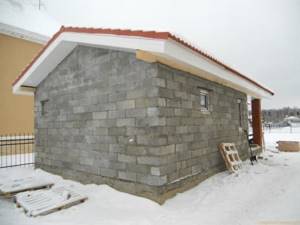
In order for such a bathhouse to keep warm for a long time, it must be insulated with modern materials. Moreover, such work must be carried out not only from the outside, but also from the inside. We will focus on insulating a cinder block bathhouse in this article.
What supplies and tools will be needed?
For the construction of a bathhouse you will need the following tools :
- hammer;
- order;
- level;
- lace;
- trowel;
- plumb line;
- container for mixing the solution;
- a spatula with teeth or a special container;
- electric drill with attachment.
The list shows the minimum that is needed only for the construction of walls. For foundation work, you will also need a concrete mixer, roofing material, a laser level, a water level, and a square. To equip the roof, you need the material from which the flooring will be made, as well as metal or wooden structures to create a rafter-beam system.
You also need to prepare a cinder block in the required quantity and a solution. The solution used is a cement-sand mixture , which is mixed with water in a concrete mixer or bucket using a drill.
Recommendations for the technology of lining a bathhouse with clapboard
- The material must be in the required condition. The lining must spend at least a day in climatic conditions comparable to bathhouses. Otherwise, it may dry out to cracks (if it is too wet) or swell (if it is dry), which will greatly deteriorate its appearance and performance properties.
- Nail thin slats onto the finished thermal insulation with a pitch corresponding to the width of the finishing panels. Use stainless nails (bronze, copper). The best way is to assemble the panels into a groove.
- Always mount the lining in the steam room horizontally - this will allow you to easily change the lower beams as they wear out, which will prolong the operation of the sauna for a long time.
- Wood is best suited for flooring. Any synthetic coating is poisonous at bath temperatures and is therefore not suitable. It is not advisable to use oak - it is slippery and therefore dangerous. In addition, it has a low heat capacity. It is possible to install heated floors in the dressing room and rest room.
If you approach the construction and decoration of a bathhouse creatively and wisely, then more than one generation of lovers of paired procedures will delight with its unique design and therapeutic warmth.
Main stages of construction
1. Laying the foundation. The choice is influenced by the soil of the site. Under normal conditions, it is best to equip it with pillars connected to each other by reinforced concrete beams. On difficult soil (clayey or mixed type), a strip base will look more reliable.
Due to the considerable degree of water absorption of cinder blocks, the height of the base of the bathhouse should be at least half a meter from ground level. After the concrete has completely hardened, they begin laying waterproofing. For this purpose, it is recommended to use molten bitumen and roofing felt.
2. Installation of walls. Before starting masonry work, it is necessary to start laying out the foundation of the heating furnace. The construction of external walls and internal partitions should be carried out in strict accordance with the approved project. Openings for windows and doors are left at the planned points. To further strengthen the bathhouse, reinforcing rods 10-12 mm thick are placed every two to three rows of block masonry.
3. Construction of the roof begins with the preparation of floor beams and installation of rafters. The roofing sheet is laid on the finished structure. After this, they begin to work on the ceiling.
4. Insulation of bathhouse walls made of cinder blocks. First, basalt thermal insulator is attached to the external walls with your own hands, then foil paper. The internal surfaces of the bath are finished with several layers of protective materials. Mineral wool is placed between the beams of the wooden frame. A vapor barrier with foil is secured on top.
5. Exterior finishing. The building is decorated with cheap clapboard, beautiful siding or practical plaster. The most presentable and respectable appearance will be when faced with imitation timber or façade slabs.
6. Interior design. It is better to cement the floor in the bathhouse, and then insulate it and protect it from moisture with a reliable layer of waterproofing. Molten bitumen and roofing felt are suitable for this purpose. Ceramic tiles or wooden floors are used as flooring. The walls are decorated with clapboard or wood.
approximate cost
To calculate the required number of building materials for a box, they rely on the main parameters - the size of the structure and the price of one block. First, the volume of the building as a whole is determined by summing up the length of all walls and multiplying by their height and thickness. The volumes of windows and doors are subtracted from the result obtained. The residual value is divided by the volume of one cinder block. The final number will be the required number of elements. Multiplying it by the cost of bentonite (30-35 rubles), we get the amount of costs for the construction of a bathhouse structure.
The final costs of building a bathhouse consist of a combination of prices for materials, loading and unloading and installation work, and transportation. A standard one-story structure, consisting of three rooms with an open veranda, but without internal insulation, can cost approximately 200-250 thousand rubles.
Reviews of cinder block baths
“We had to build a cinder block bathhouse due to lack of money. At first I thought it was temporary, then I’ll build something more solid. On the advice of experts, I insulated the walls of the house from the outside and inside, lined them with clapboard, and raised the floor higher. The result was such a great bathhouse that now I can’t be happier. And I definitely won’t change it.”
Grigoriev N.N., Ekaterinburg.
“Several years ago we bought a nice country house. A cinder block box from a small bathhouse was found on the property. Since there was little money left after the purchase, they decided to equip it with minimal effort. Instead of wooden blocks, the facade was faced with plaster, under which a layer of foam plastic was laid. And inside they made a frame from the profile into which mineral wool and siding were secured. It turned out to be an excellent economical option for a bathhouse.”
Alexander, Sverdlovsk.
“I always dreamed of having my own bathhouse with a steam room and brooms. When the opportunity arose, I took a swing at the log house. But harsh calculations showed that I couldn’t afford that amount, so I had to save money and replace it with a cinder block. But the inside of the walls was finished with a wooden block. Now there is just a fabulous forest smell in the steam room. My family and all my friends appreciated the beauty.”
Zadorin Nikolay, Kostroma.
“I built a small bathhouse at the dacha with my own hands. I tried to properly insulate the walls, floor, ceiling and protect from moisture. The bathhouse is heated by a conventional wood-burning stove. Literally two hours later, the temperature in the steam room rises to such a temperature that any sauna would envy. The whole family has been using the sauna regularly for three years now. Since then, neither adults nor children have ever had a cold.”
Evgeny Ilchenko, Moscow region.



